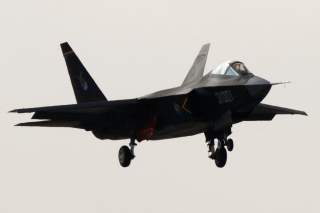Coming Soon to China's Aircraft Carriers: The JC-31 Stealth Fighter?
The People's Liberation Army Navy could buy "fourth-generation" FC-31 fighters from the Shenyang Aircraft Design Institute to replace older J-15s, state-run Global Times reported.
The Chinese navy reportedly is considering acquiring a new stealth fighter to replace existing carrier-launched warplanes that have proved unreliable and unsafe.
The People's Liberation Army Navy could buy "fourth-generation" FC-31 fighters from the Shenyang Aircraft Design Institute to replace older J-15s, state-run Global Times reported.
In Chinese military parlance, a "fourth-generation" plane is a stealthy plane with modern sensors and weapons. The rest of the world refers to such aircraft as "fifth-generation."
"Multiple changes and upgrades are being made to the FC-31 allowing it to be used on an aircraft carrier," Global Times reported an unnamed military source as saying.
The J-15 is a Shenyang-built copy of the Russian Su-33. A series of mechanical failures and four crashes involving J-15s prompted the Chinese navy to begin work on a replacement, the Hong Kong-based South China Morning Post reported.
Russia has had its own problems with its Su-33s. In 2005 and again in 2016 Su-33s crashed after arrestor cables broke aboard the Russian aircraft carrier Kuznetsov. The fighters lacked the energy to take off again and instead plummeted into the sea.
Global Times and other news outlets have cited, as evidence of Beijing's interest in buying FC-31s, various requests-for-proposals and tenders that the Shenyang Aircraft Design Institute has published apparently in order to upgrade the FC-31 for carrier operations.
Shenyang independently developed the FC-31 in the hope of selling it to the Chinese military or foreign air arms. That has changed. "The FC-31 is no longer export-oriented, and is destined for domestic military service," Global Times claimed.
The two-engine, twin-tail FC-31 first flew in 2012. Shenyang has continued to refine the type while the Chinese air force acquires the larger J-20 stealth fighter from a different company for front-line use.
There was speculation early on that the Shenyang intended for the FC-31 to have a naval role. The type features the heavy-duty landing gear and twin nosewheel that are standard on carrier aircraft that must endure high-impact landings.
The same bulky landing gear pointed to a naval mission for China Aerospace Science and Industry Corporation's Tian Ying jet-powered drone. In January 2018 Global Times cited an unnamed military official saying that the drone would operate from future Chinese carriers.
As a carrier plane, the FC-31 could face some limitations that have vexed the J-15. China's first two carriers Liaoning and Shandong lack the catapults that the U.S. Navy's own flattops use to boost heavy aircraft off their decks.
Instead, Liaoning and Shandong feature elevated ramps that give launching aircraft a modest lift bonus as they take off strictly under their own power. The constraints of the ramp take-off method prevent J-15s from carrying heavy loads of weapons and fuel, limiting their effectiveness in combat.
The FC-31 likewise would be comparatively ineffective if the Chinese navy embarked the type on those vessels.
Future Chinese carriers could feature steam-powered or electromagnetic catapults. China's third carrier, which as of early 2019 was under construction in Shanghai, reportedly has catapults.
When that ship enters service sometime in the 2020s, it could be the first Chinese flattop capable of effectively deploying the FC-31. As of early 2019, a typical Chinese carrier air wing possessed as many as 30 aircraft, usually a mix of J-15s and helicopters. China is developing a carrier-compatible early-warning aircraft similar to the U.S. Navy's own carrier-borne E-2.
In the best case scenario for China, the United States still would be years ahead when it comes to putting stealth fighters on carrier decks. The U.S. Navy in December 2018 certified its first squadron of F-35C stealth fighters, clearing the unit for routine operations.
The U.S. Navy could declare the squadron combat-ready as early as February 2019, military officials have said. The F-35C is due to deploy for the first time in 2021, to the Pacific region aboard the carrier USS Carl Vinson.
Chinese officials reportedly hope the FC-31 can counter the F-35C and other American stealth aircraft. "Only a fourth-generation fighter jet can stand up against another fourth-generation fighter in an engagement without being at a significant disadvantage," Global Times quoted an unnamed military source as saying.
David Axe edits War Is Boring . He is the author of the new graphic novels MACHETE SQUAD and THE STAN.
Image: Reuters.


